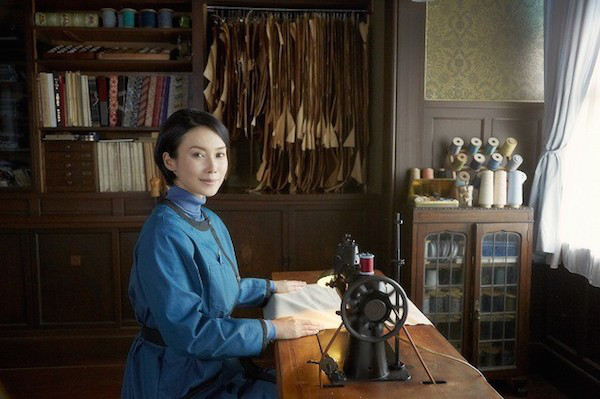A Stitch of Life
March 1, 2017 · 0 comments
By Roxy Simons.
Ichie Minami (Miki Nakatani) doesn’t want anything to change. She’s determined to keep everything in her grandmother’s dress shop the way it was when the old lady was alive. The room looks the same, the clothes are all made from designs made years before, and she still uses the traditional pedal sewing machine. People say she’s starting to look like her grandmother, and she’s happy to be compared in such a way.
In contrast to the fashionable outfits that Ichie sees young girls wear on the streets, Ichie’s creations are as stuck in the past as she is, but Fuji (Takahiro Miura) is determined to see her create her own clothing line. He’ll do anything to get her to agree to sell the clothes in his department store, including sitting in Ichie’s shop for hours eating mochi balls until the fashionista actually notices him, but Ichie is equally as determined not to change. As time goes by, though, his reasoning starts to make sense to her, and this leads Ichie to re-evaluate everything she believes in.
For director Yukiko Mishima, taking a human interest story like this and bringing it to life on screen is something of a speciality. She likes to present characters that want to preserve, or return to, a traditional way of life, and has previously looked at characters returning to their family’s vineyard (A Drop of the Grapevine) or that want to move to a small town to open a bakery (Bread of Happiness). It makes sense that she would want to adapt Aoi Ikebe’s manga. Ichie feels it’s her duty to carry on her grandmother’s work after she passed on and she’s against changing anything or even adding her own designs. She’s stubborn and unwavering in the face of outside forces and this makes her a perfect character for Mishima to work with.
Approaching the topic with an artistic flair, the director is able to present the preservation of traditional sewing quite well. The process is slow but realistic, and we see Ichie sow each stitch with care and precision. That Miki Nakatani actually learnt how to alter the clothes herself, even going so far as to learn how to use the old pedal machine that is featured in the film, is an added bonus. The clothes, designed by Sachiko Ito, have a story to tell as they’re passed down from generation to generation and altered to suit different occasions. From a dress that’s reformed into a gardening apron, to the glamorous frocks that the town’s adults (here defined as 30-year-olds and over) wear at an annual ball, each presents a scenario that helps to develop Ichie as a character.
However, a lot of the film’s runtime is spent following Fuji as he watches Ichie take on jobs from local clients. Mishima’s directorial eye focuses on the way in which Ichie works and her determination not to change, but very little else, soften feeling a little excessive for a film that’s nearly two hours long. While it’s interesting to see a person go out of their comfort zone, it goes at an excruciatingly slow pace, and there’s no real pay-off at the end either, so it is hard to really invest in the story. The lack of a satisfying conclusion can probably be attributed to the fact that the live-action was filmed before the 6-volume manga had actually finished, but even then it would hardly make up for the pacing issues. Just like Ichie’s creations, the story is woven slowly and in great detail, but it doesn’t stand out as much as the clothes when it’s over.
A Stitch of Life is screening in the UK as part of the Japan Foundation film tour.
Aoi Ikebe, cinema, Japan, Japan Foundation, manga, Roxy Simons, Stitch of Life, Yukiko Mishima

Leave a Reply